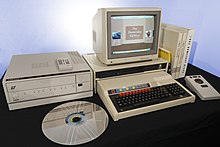
Digital obsolescence is the risk of data loss because of inabilities to access digital assets, due to the hardware or software required for information retrieval being repeatedly replaced by newer devices and systems, resulting in increasingly incompatible formats.[2][3] While the threat of an eventual "digital dark age" (where large swaths of important cultural and intellectual information stored on archaic formats becomes irretrievably lost) was initially met with little concern until the 1990s, modern digital preservation efforts in the information and archival fields have implemented protocols and strategies such as data migration and technical audits, while the salvage and emulation of antiquated hardware and software address digital obsolescence to limit the potential damage to long-term information access.[3][4][5]
- ^ Darlington, J., Finney, A., & Pearce, A. (2003, July 30). Domesday Redux: The rescue of the BBC Domesday Project Videodiscs. Ariadne. Retrieved December 17, 2021 from http://www.ariadne.ac.uk/issue36/tna/.
- ^ Mason, S. (2018). Digital preservation at Oxford and Cambridge training programme pilot. University of Oxford. Retrieved 17 December 2021 from https://libguides.bodleian.ox.ac.uk/digitalpreservation/risks.
- ^ a b "Obsolescence – a key challenge in the digital age – National Archives of Australia". 17 March 2014. Archived from the original on 17 March 2014. Retrieved 11 March 2023.
- ^ Deljanin, Sandra. (2012). Digital Obsolescence. INFOtheca, 13(1), 43–53.
- ^ Rothenberg, J. (1999). Avoiding technological quicksand: Finding a viable technical foundation for Digital Preservation: A report to the Council on Library and Information Resources. Council on Library and Information Resources.